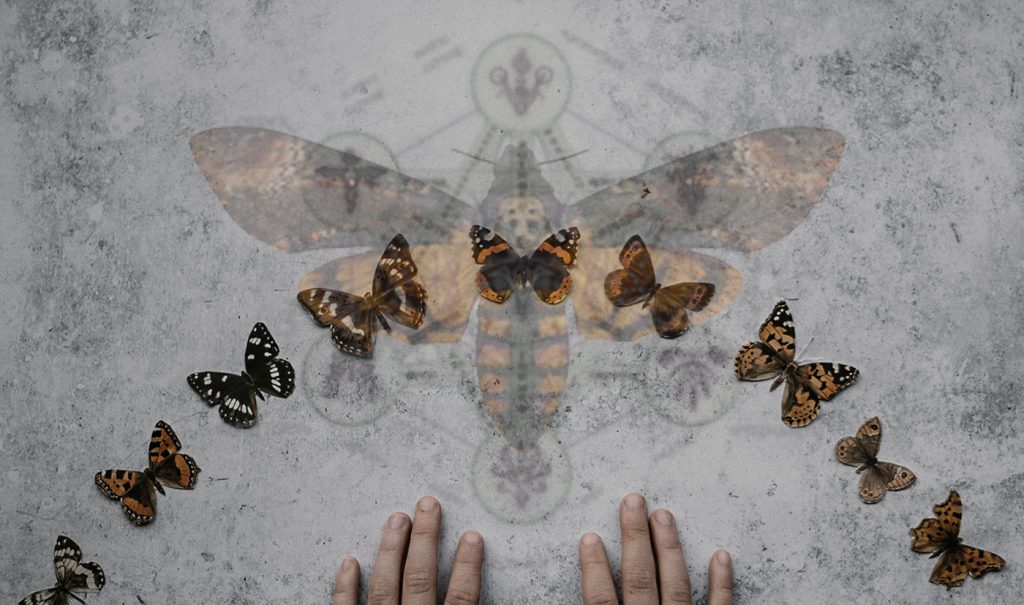
Luminary Blackthorn
Author, founder of the Temple of Chrysalis

Telea Heosphoros
Translation
The Kaleidoscopic system is the Temple of Chrysalis’ theory of perception and personality.
The Temple of Chrysalis perceives realities and the world through six principal aspects. These aspects are called the Kaleidoscopes. The Kaleidoscopes are, as it were, master categories, and various themes are connected to them. For instance, Lamproptera is the Kaleidoscope of passion and the self, and it is associated with the arts, creativity, sexuality, charisma, pleasure, and the nurturing of one’s own wellbeing, among other things.
The Kaleidoscopes help analyze different situations, thoughts, and feelings. In addition, they can be used to illustrate a person’s current behavioural and personality structure. All the Kaleidoscopes are found in every person, but in slightly different ratios to each other. Each Kaleidoscope has three subtypes; by combining these master and subtypes in different ratios, countless different personality descriptions can be made.
At the present time, the Kaleidoscopic system is primarily based on empirical observation. The system does acknowledge that a person’s culture, time period, and state of mental health influence how they exhibit their Kaleidoscopic structure. Furthermore, the system makes the distinction of our defensive Kaleidoscopes, or the so-called masking Kaleidoscopes: an outwardly flamboyant, emotionally unstable person can be a Lamproptera in the eyes of others—though in fact, deep within, they are actually exhibiting Trogonoptera, the Kaleidoscope of suffering, which they are hiding behind that mask.
Read below a description of each Master Kaleidoscope:
The kaleidoscopes
Lamproptera
Aspect: Passion
Themes: Creativity, sexuality, emotions
Counterpart: Dryocampa
“What makes me dazzle?”
The Kaleidoscope of Lamproptera deals with everything the living soul burns for. The themes connected to Lamproptera are part of the heat of emotion, pleasure, and the manifesting of the internal flame. Lamproptera guides us to seek what energizes us and gives us pleasure and joy. It also teaches us to make use of emotions while shaping reality.
The Lamproptera person:
Lamproptera people are people of strong emotion. Their internal fire can burn for different things like the arts, creativity, or pleasure-seeking. The Lamproptera appreciates aesthetics and usually has an inventive mind. A Lamproptera with a powerful aura can also be quite the sight, one who might light up the whole space with their presence when they step into the room.
At best, the Lamproptera is a gorgeous thing, a creative artist, and a sexually rich passionate soul who sees beauty where others do not. On the other hand, the internal fire can become a challenge: the Lamproptera can sometimes be self-centred, hot-tempered, stubborn, or attention-seeking. They don’t always consider others, and especially when upset, might not give a damn if they offend someone.

Dryocampa
Aspect: Interaction
Themes: Empathy, communication, understanding
Counterpart: Lamproptera
“How do I act in relation to others, meeting the needs of others?”
This Kaleidoscope explores communication and interaction between living (and why not also inanimate) things. Dryocampa teaches us how to view things from others’ perspectives, and to understand people even when it feels like no understanding can be found. The aspect of Dryocampa is all about how energy flows outwards from a living being, and where it goes.
The Dryocampa person:
The Dryocampa person is an empathetic and sympathetic human being, often with strengths in the field of friendship. They consider every word and usually strive not to hurt anyone. Thus a Dryocampa-predominant person is very considerate and thinks about the feelings of others more than average. At times the Dryocampa traits manifest as social talent, diplomacy, and ability to find solutions. At other times, the Dryocampa finds gratification in getting to help and care for others.
Empathy and thinking about others can, on the other hand, make the Dryocampa’s life difficult. At worst, the Dryocampa person is a pleaser who always says whatever they imagine others want to hear. Because validation received from others is at least as important to the Dryocampa as validation given to others, bad experiences can cause social situations to grow intimidating and evolve into anxiety.

Trogonoptera
Aspect: Darkness
Themes: Suffering, negativity, own boundaries
Counterpart: Ceranchia
“A star in the dark guides the lost moth.”
Trogonoptera, the Kaleidoscope of the themes of suffering and darkness, deals with things often deemed negative. Trogonoptera seeks the purpose of suffering, and insight into one’s own suffering-induced traits. Moreover, this Kaleidoscope guides one into establishing one’s boundaries, and helps sail even the darkest seas with no recourse but one’s own mental compass.
The Trogonoptera person:
Trogonoptera often emerges as part of one’s personality through life experience. Every trauma, every painful experience, every disappointment increases the presence of darkness, sorrow, and pain in a person. On the other hand, a person can also be inherently in love with the themes of darkness, and exhibit these traits as, for example, a dark sense of aesthetics, without any traumatic experiences whatsoever.
At best, a mature, well-rounded Trogonoptera is a person who knows how to set their boundaries, and understands suffering, both their own and that of others, thus being balanced with e.g. their Dryocampa and Ceranchia. At worst, the Trogonoptera is a cynical, spiteful, sarcastic, broken person who scorns warmth and love, and whose internal brokenness backfires, spreading the pain into their surroundings.

Ceranchia
Aspect: Brightness
Themes: Happiness, connectedness, enlightenment
Counterpart: Trogonoptera
“All is connected—we are everything and nothing.”
The thematics of Ceranchia are the most abstract of all the Kaleidoscopes. It would be easy to label it as being solely about themes antithetical to Trogonoptera: joy, happiness, charity, universal love, and goodness. However, Ceranchia is also about much larger things: all existence, the unity of living things, and the power of nature.
The Ceranchia person:
The Ceranchia person usually manifests the themes of the Kaleidoscope in a somewhat more earthly and concrete way: the Ceranchia person tends to be benevolent, warm-hearted, keen-sensed, and authentic.
At best, the Ceranchia is a person whose friendly, clean, balanced air you want to fill your lungs with. They have a golden presence, and they bring about much good around them. They are the closest to enlightenment, close to the threshold of the next reality. At worst, the Ceranchia person is a “social justice warrior” pushing their goodness, or an inquisitor forcing the world into a mold of their own liking, not realizing that love is not created through hate and destruction: they justify their harmful behaviour towards others by their own morals and ethics. A distorted Ceranchia is quick to take on a holier-than-thou attitude, and to fill their internal void by always seeking new justice battles to fight, without ever finding complete satisfaction.

Parthenos
Aspect: Order
Themes: Science, logic, the machine
Counterpart: Actias
“Things are to be approached rationally.”
Parthenos is the Kaleidoscope of the natural sciences, structures, and logic. The aspect leans towards everything clearly demonstrable, systematizable, or presentable as science. Parthenos is fundamentally a counterforce to the supernatural, although the matter is not quite so black-and-white.
The Parthenos person:
The Parthenos person is often someone who is reasonable, logically inclined, and puts their faith in the sciences. Modernity and aptitude in the field of technology are typical to the Parthenos. Equally typical to the Parthenos is a desire for order—in their own way anyway; the Parthenos person is rule-oriented and likes things to be where their place is.
The high intelligence of the Parthenos can be a detriment in social relations. The Parthenos is not interested in anything frivolous—and sometimes what counts as frivolous are the feelings of others. The humour of the Parthenos can be mean and sarcastic. The need for order and control can make the Parthenos a rigid, difficult, fastidious nitpicker seeking out every fault in others.

Actias
Aspect: The supernatural
Themes: Spirituality, magic, the unexplained
Counterpart: Parthenos
“Magic is everywhere.”
Actias explores everything we cannot prove scientifically. All things supernatural, spiritual, and weird are the realm of Actias. The nature of Actias is somewhat psychedelic, and it is important for a Chrysalid leaning on Actias to understand what is magic—and what is madness, or a trip.
The Actias person:
Strong Actias people are a touch rarer. The Actias person exudes magic, weirdness, spirituality, and often a tad of eccentricity. They can be a witch, shaman, magician, or represent some other spiritual path. The stereotypical Actias is often also a bit of a child of nature, and experiences connectedness with the forest and the powers that inhabit it.
The Actias can, like its counterpart Parthenos, sometimes be socially awkward, but for different reasons. The Actias isn’t always aware of social rules, but operates with one foot permanently out of common reality. This might cause others to feel uncomfortable, and the alienated Actias occasionally becomes a target of bullying. Actiases also sometimes become too enchanted with their own world, which can result in pursuing it by desperate means: the Actias is prone to falling in love with the world of psychedelics, and occasionally part of the mind permanently remains there, in the reality of Actias.

"How do I figure out my own Kaleidoscopic structure?"
- Every Kaleidoscope is in every one of us.
- What Kaleidoscopic personality you represent is defined by how much of the traits of a particular kaleidoscope are in you.
- Often a person will have 2–3 main Kaleidoscopes which affect more than the others. The more you have traits of a single Kaleidoscope, the more clearly it tops your Kaleidoscopic structure.
- Example 1: “I’m a logical, atheistic, science-reliant person. I like structure. I’m also empathetic and consider others. I’m afraid of offending others.” → Parthenos-Dryocampa
- Example 2: “I’m a creative, emotionally rich performer. I get described as a sparkling personality. I’m sometimes unstable, depressed, and I take my pain out on others—but I guess it’s my right?” → Lamproptera-Trogonoptera
- The Temple sometimes offers Kaleidoscopic tests to take at its events. The tests usually contain various questions to form a picture of the person’s world view, emotional life, sentiments, values, and social structures.
- Chrysalids also like to take guesses on and analyze each other’s Kaleidoscopes for instance on our Discord server.



